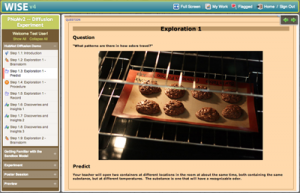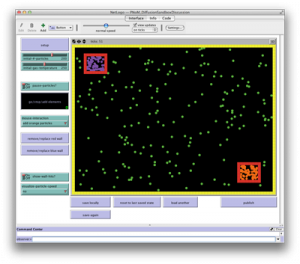The Particulate Nature of Matter unit aims to help learners to see how the physical properties of matter emerge from the interactions of many small particles. In this unit, learners will build and run experiments within virtual “sandbox” models, participate in class-wide simulations, and engage in complex engineering tasks to discover the properties and behaviors of gases.
Most of the unit will focus on the behaviors of gas particles. Students will explore various sandbox models in an attempt to not only explain interesting phenomena, such as the diffusion of an odor throughout a room, but to also quantify the relationships between various gas properties, such as pressure and temperature. During these explorations, students will be encouraged to utilize their intuitions about gases and to test these informal theories through model development and use. Ultimately, this unit helps students to see how macroscopic phenomena, such as the ability of an air mattress to support a person’s weight, emerge from the properties and interactions of many individual particles.
 A view from the WISE PNoM Unit
A view from the WISE PNoM Unit
The unit is broken up into two modules: a module focused on experimental design, and another that revolves around an engineering challenge. In both units, students are expected to make predictions, design experiments, collect and analyze data, and use evidence to defend claims. Details of the modules can be found below:
Module 1 – Diffusion Experiment
In this module students first engage in a class-wide experiment to determine how a peppermint odor, released from two different locations, diffuses throughout their classroom. Using a participatory simulation, students act as “sensors” to indicate the strength of the odor at their location throughout the experiment. The data collected from this class-wide activity, along with a visualization of the odor movement, becomes the driving phenomenon for the next activity. Here, students design and carry out an experiment within a NetLogo “sandbox” model to determine how and why the odor moves throughout the room. While carrying out their experiment, students will program and deploy virtual sensors – which will be connected to real-world indicators — into the sandbox model to quantify their results.
Module 2 – SyringIneering
Once students have become familiar with basic properties and behaviors of gas particles, the second module will help students to see how the behavior of these small particles can be used to perform work within larger physical systems. Using a sandbox model of a syringe, students become familiar with relationships between the number of particles, particle speed, pressure, temperature, and work. In the culmination of this module students are charged with designing a system within the sandbox model that will then be used to turn a wheel in a real-world system that they construct using Legos.
Using the Unit in your Classroom
The PNoM unit has been designed to require roughly 10 hours of class time. This means that if your class periods are at least an hour in length it should take you about two weeks to cover each activity. However, the pace of the unit will depend greatly on the way in which you integrate the unit with your current classroom practices.
To maximize the potential of the unit, we recommend that you provide each student with a computer. While there are some activities in the unit that will require students to work as a group, we find that students are more productive and engaged when they are able to personalize their models. However, this does not mean that the unit should be conceived of as an interaction between one student and one computer. Rather, the unit is most effective if the teacher guides students in class-wide discussions at key points throughout each module. Some of these discussion points are noted in the teacher guide though we expect teachers will make their own choices based on what they perceive to be best for their class.

